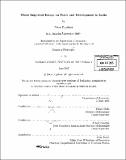Three empirical essays on trade and development in India
Author(s)
Topalova, Petia
DownloadFull printable version (8.655Mb)
Alternative title
3 empirical essays on trade and development in India
Other Contributors
Massachusetts Institute of Technology. Dept. of Economics.
Advisor
Esther Duflo and Abhijit Banerjee.
Terms of use
Metadata
Show full item recordAbstract
This thesis is a collection of three empirical essays on economic development and trade in India. Chapter 1 uses the sharp trade liberalization in India in the early 1990s, spurred to a large extent by external factors, to measure the causal impact of trade liberalization on poverty and inequality in districts in India. Variation in pre-liberalization industrial composition across districts in India and the variation in the degree of liberalization across industries allow for a difference-in-difference approach, establishing whether certain areas benefited more from, or bore a disproportionate share of the burden of liberalization. In rural districts where industries more exposed to liberalization were concentrated, poverty incidence and depth decreased by less as a result of trade liberalization, a setback of about 15 percent of India's progress in poverty reduction over the 1990s. The findings are related to the extremely limited mobility of factors across regions and industries in India. Indeed, in Indian states where inflexible labor laws impeded factor reallocation, the adverse impact of liberalization on poverty was more pronounced. The findings, consistent with a specific factors model of trade, suggest that to minimize the social costs of inequality, additional policies may be needed to redistribute some of the gains of liberalization from winners to those who do not benefit as much. Creating a flexible institutional environment will likely minimize the need for additional interventions. Using a panel of firm-level data, Chapter 2 examines the effects of India's trade reforms on firm productivity in the manufacturing sector, focusing on the interaction between this policy shock and firm and environment characteristics. (cont.) The rapid and comprehensive tariff reductions-part of an IMF-supported adjustment program with India in 1991-allow us to establish a causal link between variations in inter-industry and inter-temporal tariffs and consistently estimated firm productivity. Specifically, I find that reductions in trade protectionism led to higher levels and growth of firm productivity, with this effect strongest for private companies. Interestingly, state-level characteristics, such as labor regulations, investment climate, and financial development, do not appear to influence the effect of trade liberalization on firm productivity. Chapter 3, coauthored with my advisor Esther Duflo, studies the impact of reservation for women on the performance of policy makers and on voters' perceptions of this performance. Since the mid 1990's, one third of Village Council head positions in India have been randomly reserved for a woman: In these councils only women could be elected to the position of chief. Village Councils are responsible for the provision of many local public goods in rural areas. Using a data set which combines individual level data on satisfaction with public services with independent assessments of the quality of public facilities, we compare objective measures of the quantity and quality of public goods, and information about how villagers evaluate the performance of male and female leaders. Overall, villages reserved for women leaders have more public goods, and the measured quality of these goods is at least as high as in non-reserved villages. Moreover, villagers are less likely to pay bribes in villages reserved for women. (cont.) Yet, residents of villages headed by women are less satisfied with the public goods, including goods that are beyond the jurisdiction of the Panchayat. This may help explain why women rarely win elections even though they appear to be at least as effective leaders along observable dimensions, and are less corrupt.
Description
Thesis (Ph. D.)--Massachusetts Institute of Technology, Dept. of Economics, 2005. Includes bibliographical references.
Date issued
2005Department
Massachusetts Institute of Technology. Department of EconomicsPublisher
Massachusetts Institute of Technology
Keywords
Economics.